
Hinde Street is a street in the Marylebone district of the City of Westminster, London, that contains the Hinde Street Methodist Church and was home to the novelist Rose Macaulay until her death.

Hinde Street is a street in the Marylebone district of the City of Westminster, London, that contains the Hinde Street Methodist Church and was home to the novelist Rose Macaulay until her death.

Hinde Street runs from Manchester Square in the west to the junction of Marylebone Lane and Bentinck Street in the east. Thayer Street joins it mid way on the north side and continues as Mandeville Place on the south side.
The street was built from 1777 by Samuel Adams and named after Jacob Hinde who was the son-in-law of the ground landlord Thomas Thayer. [1]
The street is home to a number of notable buildings. The Hinde Street Methodist Church, a grade II listed building with Historic England. [2] It was built 1807–10, and rebuilt in the 1880s. [1] [3]
Number 2 on the south side is a Portman Estate development terraced town house built around 1790. The building is grade II listed [4] and occupied on the ground floor by Bishop Instruments and Bows. [5]
Numbers 11 and 12 on the north side between Manchester Square and Thayer Street are also Portman Estate terraced town houses that have shops on the ground floor and flats above. Both are grade II listed. [6] [7]
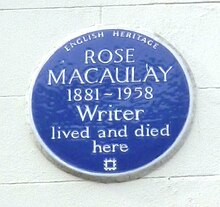

Manchester Square is an 18th-century garden square in Marylebone, London. Centred 950 feet (290 m) north of Oxford Street it measures 300 feet (91 m) internally north-to-south, and 280 feet (85 m) across. It is a small Georgian predominantly 1770s-designed instance in central London; construction began around 1776. The north side has a central mansion, Hertford House, flanked by approach ways; its first name was Manchester House — its use is since 1897 as the Wallace Collection (gallery/museum) of fine and decorative arts sits alongside the Madame Tussauds museum and the Wigmore Hall concert rooms. The square forms part of west Marylebone, most of which sees minor but overarching property interests held by one owner among which many buildings have been recognised by statutory protection.

Bryanston Square is an 800-by-200-foot garden square in Marylebone, London. Terraced buildings surround it — often merged, converted or sub-divided, some of which remain residential. The southern end has the William Pitt Byrne memorial fountain. Next to both ends are cycle parking spaces.
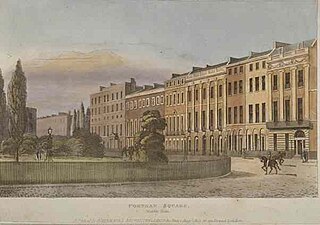
Portman Square is a garden square in Marylebone, central London, surrounded by townhouses. It was specifically for private housing let on long leases having a ground rent by the Portman Estate, which owns the private communal gardens. It marks the western end of Wigmore Street, which connects it to Cavendish Square to the east.
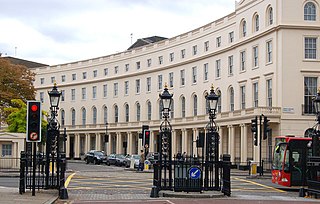
Park Crescent is at the north end of Portland Place and south of Marylebone Road in London. The crescent consists of elegant stuccoed terraced houses by the architect John Nash, which form a semicircle. The crescent is part of Nash's and wider town-planning visions of Roman-inspired imperial West End approaches to Regent's Park. It was originally conceived as a circus (circle) to be named Regent's Circus but instead Park Square was built to the north. The only buildings on the Regent's Park side of the square are small garden buildings, enabling higher floors of the Park Crescent buildings to have a longer, green northern view.
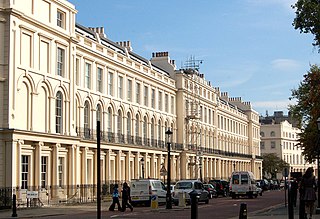
Park Square is a large garden square or private appendix to Regent's Park in London and is split from a further green, the long northern side of Park Crescent, by Marylebone Road and (single-entrance) Regent's Park tube station. It consists of two facing rows of large, very classically formed, stuccoed, terraced houses with decorative lower floor balconies and a colonnade of consecutive porticos by architect John Nash, and was built in 1823–24. Alike, shorter-length terraces flank its corners at right angles, equally Grade I listed buildings: Ulster Terrace, Ulster Place, St Andrew's Place and Albany Terrace.

Marylebone is an area in London, England and is located in the City of Westminster. It is in Central London and part of the West End. Oxford Street forms its southern boundary.

York Terrace overlooks the south side of Regent's Park in Marylebone, City of Westminster, London, England. York Terrace West is a Grade I listed building. York Terrace East contains Grade II listed buildings. 1–18 York Terrace East is listed at Grade I.

Conduit Street is a street in Mayfair, London. It connects Bond Street to Regent Street.

Thayer Street is a street in the Marylebone district of the City of Westminster, London, that contains four listed buildings.

Hinde Street Methodist Church in Hinde Street, Marylebone, London, is Grade II listed with Historic England. It was built 1807-10 and rebuilt in the 1880s.

Mandeville Place is a street in the Marylebone district of the City of Westminster, London, the buildings in which are notably more impressive than those to the immediate north and south.

James Street is a street in the Marylebone district of the City of Westminster, London, off Oxford Street, that is known for the high number of restaurants and bars that it contains.

Crawford Street is a street in the Marylebone district of the City of Westminster, London. The street contains two grade II listed public houses.

Homer Row is a street in the Marylebone district of the City of Westminster, London, that runs form Old Marylebone Road in the north to the junction of Crawford Place and Crawford Street in the south.

Crawford Place is a street in the Marylebone district of the City of Westminster, London. The street was developed in the first decade of the 1800s and was original known as John Street West.
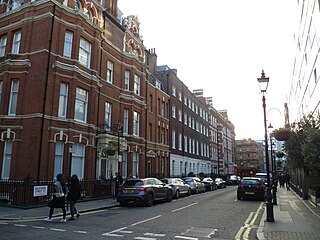
Bulstrode Street is a street in Marylebone in the City of Westminster that runs from Welbeck Street in the east to Thayer Street in the west. It is crossed only by Marylebone Lane.

9 and 11 Duke Street are grade II listed terraced townhouses in Duke Street, Marylebone, in the City of Westminster, London. The houses are on the east side of the street on the corner with Duke's Mews. They were built around 1776–1788 when the Duke of Manchester developed Manchester Square on Portman Estate land. Built of stock brick with slate roofs, they later had shop fronts added which were altered in the Victorian period. The buildings were extensively renovated in 2011–12 by Richardsons (Nyewood) Limited.

South Audley Street is a major shopping street in Mayfair, London. It runs north to south from the southwest corner of Grosvenor Square to Curzon Street.
This is a list of the etymology of street names in the London district of Marylebone. The following utilises the generally accepted boundaries of Marylebone viz. Marylebone Road to the north, Great Portland Street to the east, Marble Arch and Oxford Street to the south and Edgware Road to the west.

Chiltern Street is a road in the Marylebone area of Central London. Located in the City of Westminster, it runs north to south connecting Marylebone Road and Blandford Street. Baker Street runs parallel a little way to the west. It meets Dorset Street, Crawford Street and Paddington Street along its route. Manchester Square is located beyond the southern end of the street.
![]() Media related to Hinde Street, London at Wikimedia Commons
Media related to Hinde Street, London at Wikimedia Commons